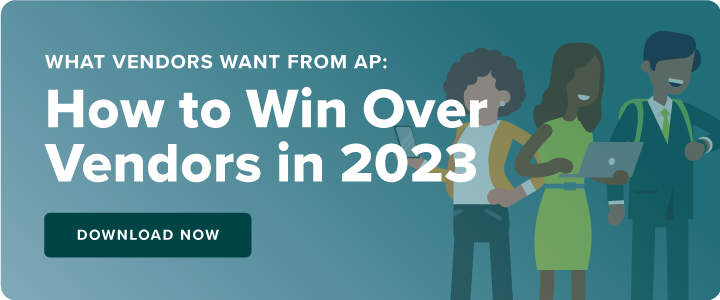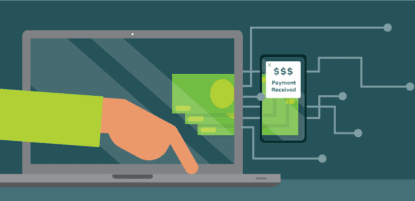Processing and paying vendor invoices have long been a burden for organizations at large. The vendor payment process involves more than just paying an invoice and staying ahead of payment deadlines–it requires security and close attention and can be the difference between successful and lacking supplier relationships.
In this article, we highlight the challenges associated with the traditional vendor payment process and reveal how an end-to-end AP automation and payment optimization solution can significantly improve efficiency for businesses and vendors alike.
What is a vendor or supplier payment?
Businesses and organizations large and small receive goods and services from multiple vendors. These vendors, or suppliers, then send an invoice to the organization, which the accounts payable (AP) department is responsible for paying. Payments for these invoices may be sent in any number of forms.
Common vendor payment types include checks, credit card payments, wire transfers, ACH (automated clearing house) payments, and virtual cards. Which payment type an AP department uses depends on multiple factors such as security of payment method, cost, convenience, and vendor preference — yet, checks remain the supreme in B2B payments. In fact, 45% of businesses still make more than 50% of their supplier payments via check, despite all their drawbacks.
What is vendor payment automation?
Vendor payment automation is an accounts payable tool that businesses can use to automate the process of paying their suppliers. When a business receives goods or services from multiple vendors, these vendors then send an invoice to the organization, which the accounts payable (AP) department is responsible for paying. Companies that have invested in accounts payable automation, can reduce manual tasks related to invoice payments, including approvals, invoice capture, and payment execution. Companies can use AP workflow automation to improve their relationships with suppliers, since suppliers have more visibility into the payment timeline and can expect more timely payments.
What are the most common vendor payment methods?
Vendors can be paid in the forms of checks, credit card payments, wire transfers, ACH payments, and virtual cards. Which type of payment an AP department uses depends on several factors such as cost, security of payment method, vendor preference, and convenience. However, despite the several advantages of electronic payments, checks remain supreme in B2B payments.
According to MineralTree’s 2023 State of the AP Report, 32% of AP departments use their current payment methods simply because it’s what they’re used to. Considering that AP is essentially the last mile of the supplier relationship, businesses may realize significant value in more streamlined vendor payment solutions that improve their current processes.
According to the MineralTree report, supplier willingness to accept ePayments is the top perceived barrier to digital payment adoption for survey respondents. At the same time, 66% of respondents indicated that supplier relationships are growing in importance, and 87% recognized that speed of payment matters most when it comes to the vendor payment experience (vendors taking the survey separately agreed.)
If done right, however, automating and digitizing the supplier payment process can lead to improvements both within the AP department and on the supplier’s end, positively impacting the supplier relationship and eliminating that perceived barrier.
What are the challenges with the current vendor payment process?
Current vendor payment processes used by many AP departments come with a number of management challenges. These include:
Complex Information Exchange Between Buyers and Suppliers
Vendor information may be exchanged via email, standard mail, phone call, or through payment systems. But if multiple methods are used by each vendor, buyers and suppliers may need to engage in manual and error-prone methods of tracking communications, which can result in a series of risk and fraud issues along the way. Whether they are malicious attempts or data entry errors, not following best practices can make it difficult to maintain an accurate and secure record of the most up-to-date details.
Lack of Visibility for Suppliers
Suppliers may have no way to tell when payment is on its way or at what stage an invoice is in an AP department’s processes. This leads to challenges predicting account balances and often requires extra work in the form of phone calls and emails in order to investigate, respond, and track down important information. This time-consuming process not only creates more manual work for your AP team but also adds pressure on the supplier’s AR team.
Difficulty Optimizing the Mix of Payment Methods
Each vendor may have different payment preferences and these can evolve. In light of the pandemic and related challenges, many suppliers actively sought out ePayments due to the difficulty with collecting and processing checks. From the AP department’s side, this can mean manually tracking and executing multiple different types of payments, which adds to the effort required to pay vendors.
Lack of Data Visibility and Analytics
AP and AR (accounts receivable) departments need ways to both measure their current effectiveness and determine if process changes are improving those measures. For example, metrics such as Days Sales Outstanding (DSO) are important for suppliers so they can accurately track invoice payments and predict cash inflow and help buyers avoid exceeding their credit limits.
How to improve vendor payments with a payment automation solution
The right AP and payment automation solution can help AP departments and vendors alike by streamlining onboarding, improving communication, reducing costs and fraud risk, and enabling centralized processing, reporting, and analytics. Here’s how your team can use AP automation to more effectively manage AP:
1. Streamline vendor onboarding
A proper payment automation solution will make the vendor onboarding process easy for both the AP department and the vendor. Robust supplier enablement starts with focused onboarding during adoption of the new solution, then transitions to an ongoing process.
A continuous onboarding strategy aims to keep the door open for current suppliers who may later change their payment preferences, while also streamlining the onboarding process for all new suppliers. Onboarding should happen quickly and in an automated fashion in order for businesses to realize benefits. In addition, businesses can reach their goal of maximizing savings, security, and rebates while simultaneously accommodating supplier payment preferences. As a result, friction from the AP process is removed and both parties benefit.
2. Establish strong vendor relationships
As mentioned earlier in this article, vendor relationships are increasingly important for many businesses. Anytime an AP department makes a change to its vendor payment process, there is a chance of impacting that relationship either negatively or positively. That’s why choosing the right AP automation provider is vital.
As a payment service provider, MineralTree maintains full control over the quality of the outreach and supplier experience by handling supplier enrollment in-house. While we educate suppliers on the benefits of virtual cards and ePayments, we don’t pressure them. Instead, we work with them to identify and set up the payment method that works best for them.
3. Capture early payment discounts and reduce costs
Reducing costs is a common goal in many AP departments, and there are a few ways that AP automation can help. First, AP automation platforms reduce manual workload which translates to employee time that can be better spent elsewhere. Second, virtual card payments, which are often part of the automation process, usually come with cash back rebates just as credit cards do.
AP automation also makes it easier for organizations to take advantage of early payment discounts offered by many vendors. Vendors want to get paid, and many are used to payments taking so long to come in that they offer perks to those who pay early. The trick for AP departments is to have efficient enough processes in place that they can take advantage of those discounts, should they so choose.
MineralTree can help make that happen. In fact, MineralTree’s Invoice-to-Pay solution even enables automatic discount application, further simplifying the process of capitalizing on vendor early-pay incentives.
4. Reduce fraud risk
AP automation keeps data safe and enables payment methods with reduced fraud risk. One-time use of virtual cards, for example, are much more difficult for fraudsters to exploit. MineralTree’s TotalPay uses AWS bank-level encryption, two-factor authentication, audit trails, and fine-grained access controls to enforce least-privilege access. Additional robust internal controls and industry best practices allow for secure payment processing and supplier information management.
5. Centralize payment processing, reporting, and analytics
AP departments and vendors alike increasingly want real-time visibility and analytics, allowing them to generate reports and make timely decisions that align with business priorities. MineralTree’s TotalAP provides access to real-time dashboards that visualize KPIs such as invoice aging, payment mix, and rebates earned.
6. Reduce AP workflows, while paying suppliers in their preferred payment method
Traditionally, new payment methods resulted in new accounts payable workflows, adding more time-consuming and manual processes to set up and maintain. By leveraging MineralTree’s AP automation platform, your team can pay suppliers in their preferred method in one AP workflow.
7. Enroll more vendors in electronic payments
MineralTree can use its system to check which suppliers have already enrolled in virtual card payments. Our team will also help you enroll strategic suppliers in electronic payment methods such as B2B virtual cards, which can save your company resources while creating another revenue stream.
Forge Biologics, a gene therapy manufacturer, was able to take advantage of early payment discounts by leveraging SilveryPay, MineralTree’s virtual card payment tool. Steve Goden, their SVP of Finance noted that “Thanks to MineralTree, we’re on pace to earn at least $80,000 in virtual card rebates this year – a significant amount that completely offsets our platform fees and even puts money back into our general funds.”
Automate and optimize the vendor payment process with MineralTree
Let MineralTree take care of supplier onboarding, payments, and payment inquiries for you. We process $18 billion annually in total payment volume and can help your business implement automated AP solutions in as little as four weeks or less.
MineralTree’s TotalAP is an end-to-end AP automation solution delivering unrivaled processing speed, quality, and security. Features include invoice capture and approval, payment authorization, execution, and optimization, and real-time AP analytics. Maximize the benefits of B2B ePayments with continuous supplier enrollment and supplier inquiry support, while increasing efficiency and optimizing supplier relationships with MineralTree.
Frequently asked questions
How do companies pay vendors?
Companies can pay vendors for their services in a number of forms including checks, credit card payments, wire transfers, ACH payments, and virtual cards. This vendor payment process can happen either manually — where vendor invoices are received, captured, processed, authorized, and paid — or by utilizing an AP automation platform that streamlines and automates the entire vendor payment workflow.
What are vendor payment terms?
Vendor payment terms are the pre-established conditions in which the vendor identifies the time period in which a company has to pay for vendor services or goods. Traditionally, these terms are “net 10”, “net 30”, “net 60”, etc. identifying the number of days each company has to pay their suppliers. The longer the term of days, the more time your business has to pay each vendor invoice.
What is the vendor payment process?
The vendor payment process is one of the last steps in the purchase to pay life cycle, where a company pays their suppliers for purchased goods or services performed. The traditional vendor payment process can be outlined in the following steps:
- Company receives invoice from vendor
- Company manually enters invoice information
- Controller or CFO approves vendor invoice
- Vendor invoice payment is authorized by controller or CFO
- Vendor payment is executed
While there are several steps within the vendor payment process, AP departments can leverage an accounts payable automation platform to streamline and secure the process of paying vendors.
How do suppliers get paid?
Companies are responsible for paying their vendors once a service has been performed or goods have been received — and they can pay their vendors in a few different ways. Suppliers can get paid via credit card payments, wire transfers, checks, ACH payments, or virtual cards. How fast each supplier is paid depends on the selected payment type.
What are best practices for onboarding suppliers?
Maintaining strong and trustworthy relationships with your suppliers is an extremely important business practice, and it starts with successful supplier onboarding. Here are the best practices for onboarding new suppliers:
- Establish evaluation and approval guidelines
- Identify supplier requirements and expectations
- Create processes that identify and prioritize strategic supplier relationships
- Centralize your AP processes
- Leverage an AP automation solution
What are the payment methods for vendors?
Payment methods vary depending on the vendor and the type of work conducted. That said, vendors can accept payments via check, credit card, virtual card, ACH payments, Purchase Orders (POs), wire transfer, etc.
How do you process a vendor payment?
Vendor payments can be processed via manual accounts payable, or through an automated payment system that streamlines the entire end-to-end payment process.




